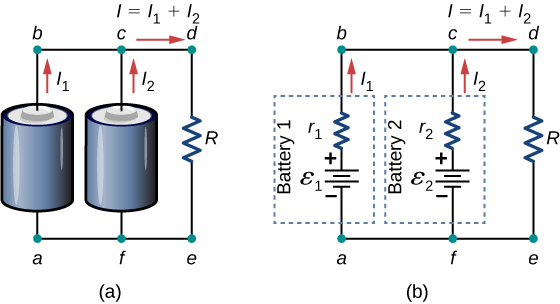| << Chapter < Page | Chapter >> Page > |
When voltage sources are in series, their internal resistances can be added together and their emfs can be added together to get the total values. Series connections of voltage sources are common—for example, in flashlights, toys, and other appliances. Usually, the cells are in series in order to produce a larger total emf. In [link] , the terminal voltage is
Note that the same current I is found in each battery because they are connected in series. The disadvantage of series connections of cells is that their internal resistances are additive.
Batteries are connected in series to increase the voltage supplied to the circuit. For instance, an LED flashlight may have two AAA cell batteries, each with a terminal voltage of 1.5 V, to provide 3.0 V to the flashlight.
Any number of batteries can be connected in series. For N batteries in series, the terminal voltage is equal to
where the equivalent resistance is .
When a load is placed across voltage sources in series, as in [link] , we can find the current:
As expected, the internal resistances increase the equivalent resistance.

Voltage sources, such as batteries, can also be connected in parallel. [link] shows two batteries with identical emfs in parallel and connected to a load resistance. When the batteries are connect in parallel, the positive terminals are connected together and the negative terminals are connected together, and the load resistance is connected to the positive and negative terminals. Normally, voltage sources in parallel have identical emfs. In this simple case, since the voltage sources are in parallel, the total emf is the same as the individual emfs of each battery.

Consider the Kirchhoff analysis of the circuit in [link] (b). There are two loops and a node at point b and .
Node b : .
Loop abcfa :
Loop fcdef :
Solving for the current through the load resistor results in , where . The terminal voltage is equal to the potential drop across the load resistor . The parallel connection reduces the internal resistance and thus can produce a larger current.
Any number of batteries can be connected in parallel. For N batteries in parallel, the terminal voltage is equal to
where the equivalent resistance is .
As an example, some diesel trucks use two 12-V batteries in parallel; they produce a total emf of 12 V but can deliver the larger current needed to start a diesel engine.
In summary, the terminal voltage of batteries in series is equal to the sum of the individual emfs minus the sum of the internal resistances times the current. When batteries are connected in parallel, they usually have equal emfs and the terminal voltage is equal to the emf minus the equivalent internal resistance times the current, where the equivalent internal resistance is smaller than the individual internal resistances. Batteries are connected in series to increase the terminal voltage to the load. Batteries are connected in parallel to increase the current to the load.

Notification Switch
Would you like to follow the 'University physics volume 2' conversation and receive update notifications?